Improved Properties of Metallocene Polyethylene/Poly(ethylene terephthalate) Blends Processed by an Innovative Eccentric Rotor Extruder
Abstract
1. Introduction
2. Experimental Section
2.1. Materials
2.2. Equipment
2.3. Sample Preparation
2.4. Characterizations
2.4.1. Scanning Electronic Microscope (SEM)
2.4.2. Differential Scanning Calorimetry (DSC)
2.4.3. Dynamic Rheology Measurements
2.4.4. Mechanical Measurements
3. Results and Discussion
3.1. Morphology Analysis
3.2. Differential Scanning Calorimetry (DSC) Test
3.3. Dynamic Rheology Properties
3.4. Mechanical Properties
4. Conclusions
Author Contributions
Funding
Conflicts of Interest
References
- Nitta, K.; Suzuki, K.; Tanaka, A. Comparison of tensile properties in the pre-yield region of metallocene-catalyzed and Ziegler-Natta-catalyzed linear polyethylene. J. Mater. Sci. 2000, 35, 2719–2727. [Google Scholar] [CrossRef]
- Kennedy, M.A.; Peacock, A.J.; Failla, M.D.; Lucas, J.C.; Mandelkern, L. Tensile Properties of Crystalline Polymers: Random Copolymers of Ethylene. Macromolecules 1995, 28, 1407–1421. [Google Scholar] [CrossRef]
- Utracki, L.A. Polymer Blends Hand Book; Springer: Dordrecht, The Netherlands, 2002. [Google Scholar]
- Dimitrova, T.L.; La Mantia, F.P.; Pilati, F.; Toselli, M.; Valenza, A.; Visco, A. On the compatibilization of PET/HDPE blends through a new class of copolyesters. Polymer 2000, 41, 4817–4824. [Google Scholar] [CrossRef]
- Xanthos, M.; Dagli, S. Compatibilization of polymer blends by reactive processing. Polym. Eng. Sci. 1991, 31, 929–935. [Google Scholar] [CrossRef]
- Kalfoglou, N.K.; Skafidas, D.S.; Kallitsis, J.K.; Lambert, J.C.; Van der Stappen, L. Comparison of Compatibilizer effectiveness for PET/HDPE blends. Polymer 1995, 36, 4453–4462. [Google Scholar] [CrossRef]
- Xue, B.; He, H.Z.; Huang, Z.X.; Zhu, Z.W.; Xue, F.; Liu, S.M.; Liu, B. Fabrication of super-tough ternary blends by melt compounding of poly(lactic acid) with poly(butylene succinate) and ethylene-methyl acrylate-glycidyl methacrylate. Compos. Part B Eng. 2019, 172, 743–749. [Google Scholar] [CrossRef]
- Xue, B.; He, H.Z.; Zhu, Z.W.; Li, J.Q.; Huang, Z.X.; Wang, G.Z.; Chen, M.; Zhan, Z.M. A Facile Fabrication of High Toughness Poly (lactic Acid) via Reactive Extrusion with Poly (butylene Succinate) and Ethylene-Methyl Acrylate-Glycidyl Methacrylate. Polymers 2018, 10, 1401. [Google Scholar] [CrossRef] [PubMed]
- Pracella, M.; Rolla, L.; Chionna, D.; Galeski, A. Compatibilization and properties of poly (ethylene terephthalate)/polyethylene blends based on recycled materials. Macromol. Chem. Phys. 2002, 203, 1473–1485. [Google Scholar] [CrossRef]
- Zhang, H.; Guo, W.; Yu, Y.; Li, B.; Wu, C. Structure and properties of compatibilized recycled poly (ethylene terephthalate)/linear low density polyethylene blends. Eur. Polym. J. 2007, 43, 3662–3670. [Google Scholar] [CrossRef]
- Zhang, H.; Zhang, Y.; Guo, W.; Xu, D.; Wu, C. Thermal Properties and Morphology of Recycled Poly (ethylene terephthalate)/Maleic Anhydride Grafted Linear Low-Density Polyethylene Blends. J. Appl. Polym. Sci. 2008, 109, 3546–3553. [Google Scholar] [CrossRef]
- Zhang, Y.; Guo, W.; Zhang, H.; Wu, C. Influence of chain extension on the compatibilization and properties of recycled poly (ethylene terephthalate)/linear low density polyethylene blends. Polym. Degrad. Stab. 2009, 94, 1135–1141. [Google Scholar] [CrossRef]
- Jayanarayanan, K.; Ravichandran, A. Morphology and Mechanical Properties of Normal Blends and In-Situ Microfibrillar Composites from Low-Density Polyethylene and Poly (ethylene terephthalate). Polym-Plast Technol. 2010, 49, 442–448. [Google Scholar] [CrossRef]
- Qu, J.P. Polymer Plasticating and Conveying Method and Equipment based on Elongational Rheology. CN Patent 200810026054, 25 January 2008. [Google Scholar]
- Qu, J.P.; Yang, Z.T.; Yin, X.C.; He, H.Z.; Feng, Y.H. Characteristics Study of Polymer Melt Conveying Capacity in Vane Plasticization Extruder. Polym-Plast Technol. 2009, 48, 1269–1274. [Google Scholar] [CrossRef]
- Qu, J.; Zhang, N.; Yu, X.; Zhang, G.; Liu, S.; Tan, B.; Liu, L. Experimental Investigation of Polymer Pellets Melting Mechanisms in Vane Extruders. Adv. Polym. Technol. 2013, 32, 77–93. [Google Scholar] [CrossRef]
- Qu, J.P.; Chen, H.Z.; Liu, S.R.; Tan, B.; Liu, L.M.; Yin, X.C.; Liu, Q.J.; Guo, R.B. Morphology study of immiscible polymer blends in a vane extruder. J. Appl. Polym. Sci. 2012, 128, 3576–3585. [Google Scholar] [CrossRef]
- Wu, Z.H.; Zhao, Y.Q.; Zhang, G.Z.; Yang, Z.T.; Qu, J.P. Multifractal analysis on dispersion of immiscible high-density polyethylene/polystyrene blends processed via polymer vane plasticizing extruder. J. Appl. Polym. Sci. 2013, 130, 2328–2335. [Google Scholar] [CrossRef]
- Chen, Y.; Fan, J.; Wang, W.; Wang, Y.; Xu, C.; Yuan, D. Influence of size reduction of crosslinked rubber particles on phase interface in dynamically vulcanized poly (vinylidene fluoride)/silicone rubber blends. Polym. Test. 2017, 63, 263–274. [Google Scholar] [CrossRef]
- Cock, F.; Cuadri, A.A.; García-Morales, M.; Partal, P. Thermal, rheological and microstructural characterisation of commercial biodegradable polyesters. Polym. Test. 2013, 32, 716–723. [Google Scholar] [CrossRef]
- Zou, W.; Chen, R.; Zhang, G.; Zhang, H.; Qu, J. Mechanical, thermal and rheological properties and morphology of poly (lactic acid)/poly (propylene carbonate) blends prepared by vane extruder. Polym. Adv. Technol. 2016, 27, 1430–1437. [Google Scholar] [CrossRef]
- Avrami, M. Kinetics of phase change. I general theory. J. Chem. Phys. 1939, 7, 1103–1112. [Google Scholar] [CrossRef]
- Ozawa, T. Kinetics of non-isothermal crystallization. Polymer 1971, 12, 150–158. [Google Scholar] [CrossRef]
- Ziabicki, H.A. Theoretical analysis of oriented and nonisothermal crystallization. Colloid Polym. Sci. 1978, 256, 332–342. [Google Scholar] [CrossRef]
- He, Y.; Yang, Z.T.; Qu, J.P. Super-toughed poly(lactic acid)/thermoplastic poly(ether)urethane nanofiber composites with in-situ formation of aligned nanofibers prepared by an innovative eccentric rotor extruder. Compos. Sci. Technol. 2019, 169, 135–141. [Google Scholar] [CrossRef]
- Song, Y.; Zheng, Q. Concepts and conflicts in nanoparticles reinforcement to polymers beyond hydrodynamics. Prog. Mater. Sci. 2016, 84, 1–58. [Google Scholar] [CrossRef]
- Song, Y.; Zheng, Q. A Guide for Hydrodynamic Reinforcement Effect in Nanoparticle-filled Polymers. Crit. Rev. Solid State Mater. Sci. 2016, 41, 318–346. [Google Scholar] [CrossRef]
- Kiziltas, A.; Nazari, B.; Gardner, D.J.; Bousfield, D.W. Polyamide 6–Cellulose Composites: Effect of Cellulose Composition on Melt Rheology and Crystallization Behavior. Polym. Eng. Sci. 2014, 54, 739–746. [Google Scholar] [CrossRef]
- Chatterjee, T.; Krishnamoorti, R. Rheology of polymer carbon nanotubes composites. Soft Matter. 2013, 9, 9515–9529. [Google Scholar] [CrossRef]
- Parent, J.S.; Bodsworth, A.; Sengupta, S.S.; Kontopoulou, M.; Chaudhary, B.I.; Poche, D.; Cousteaux, S. Structure-rheology relationships of long-chain branched polypropylene: Comparative analysis of acrylic and allylic coagent chemistry. Polymer 2009, 50, 85–94. [Google Scholar] [CrossRef]
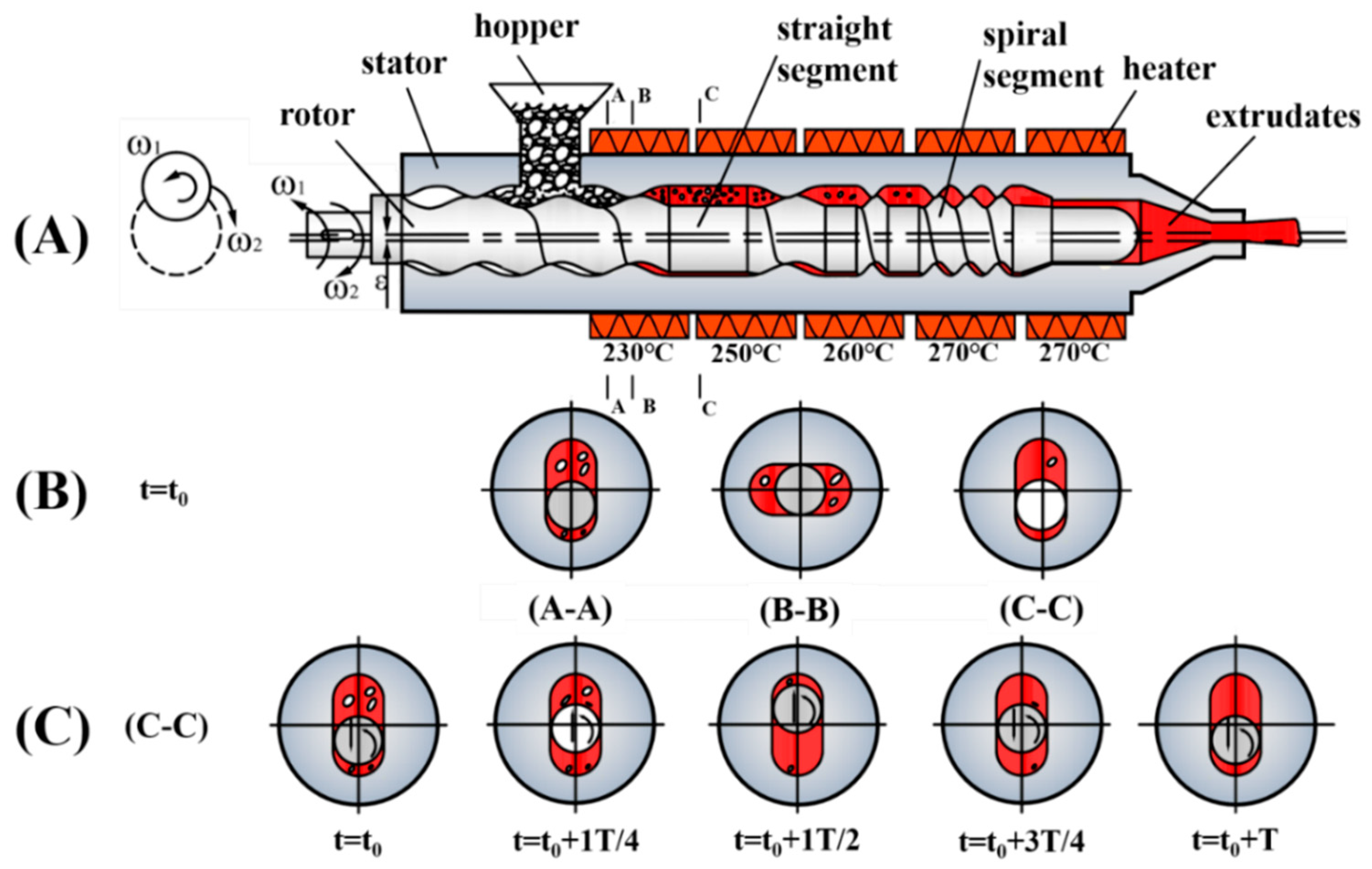
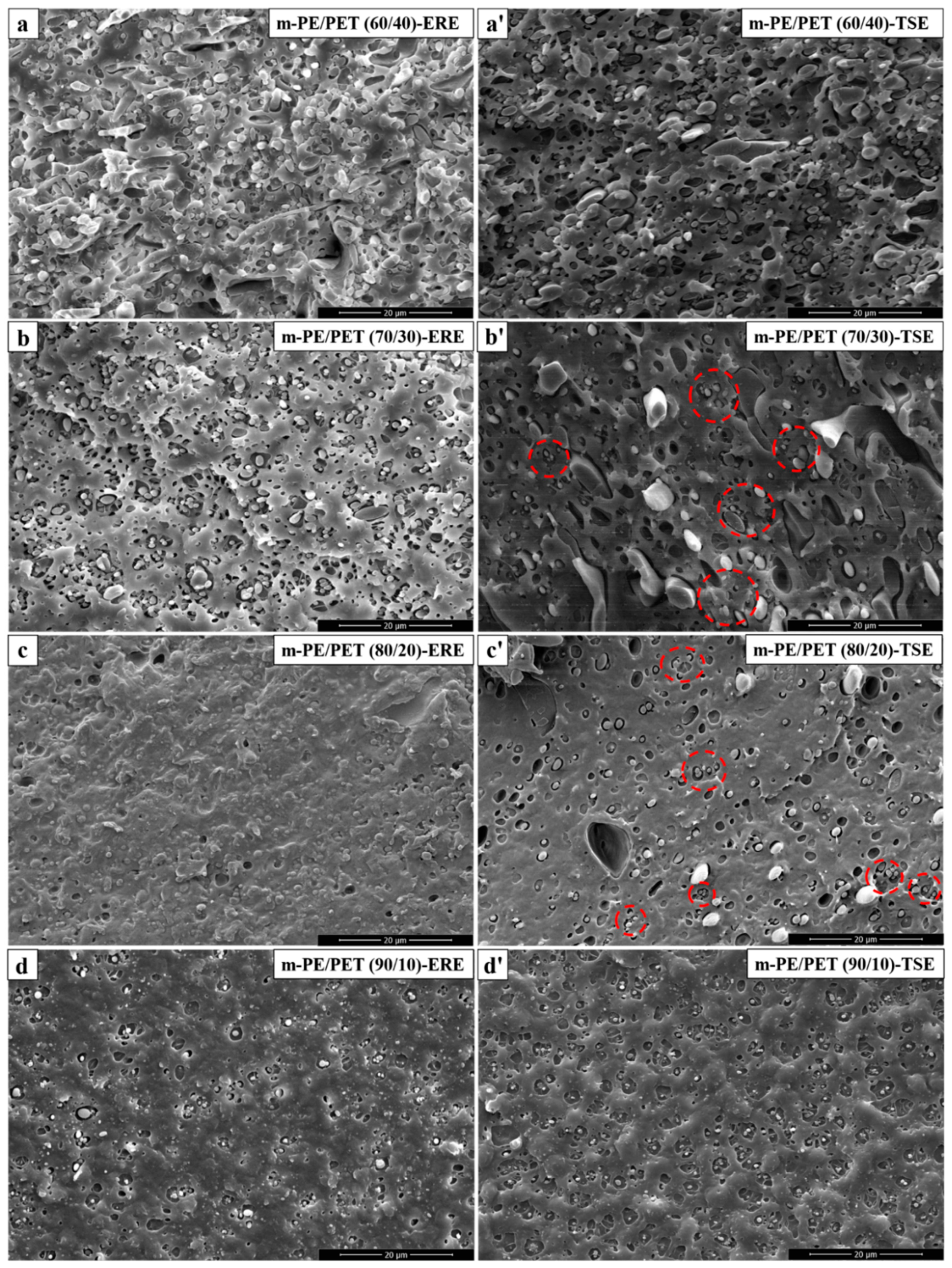

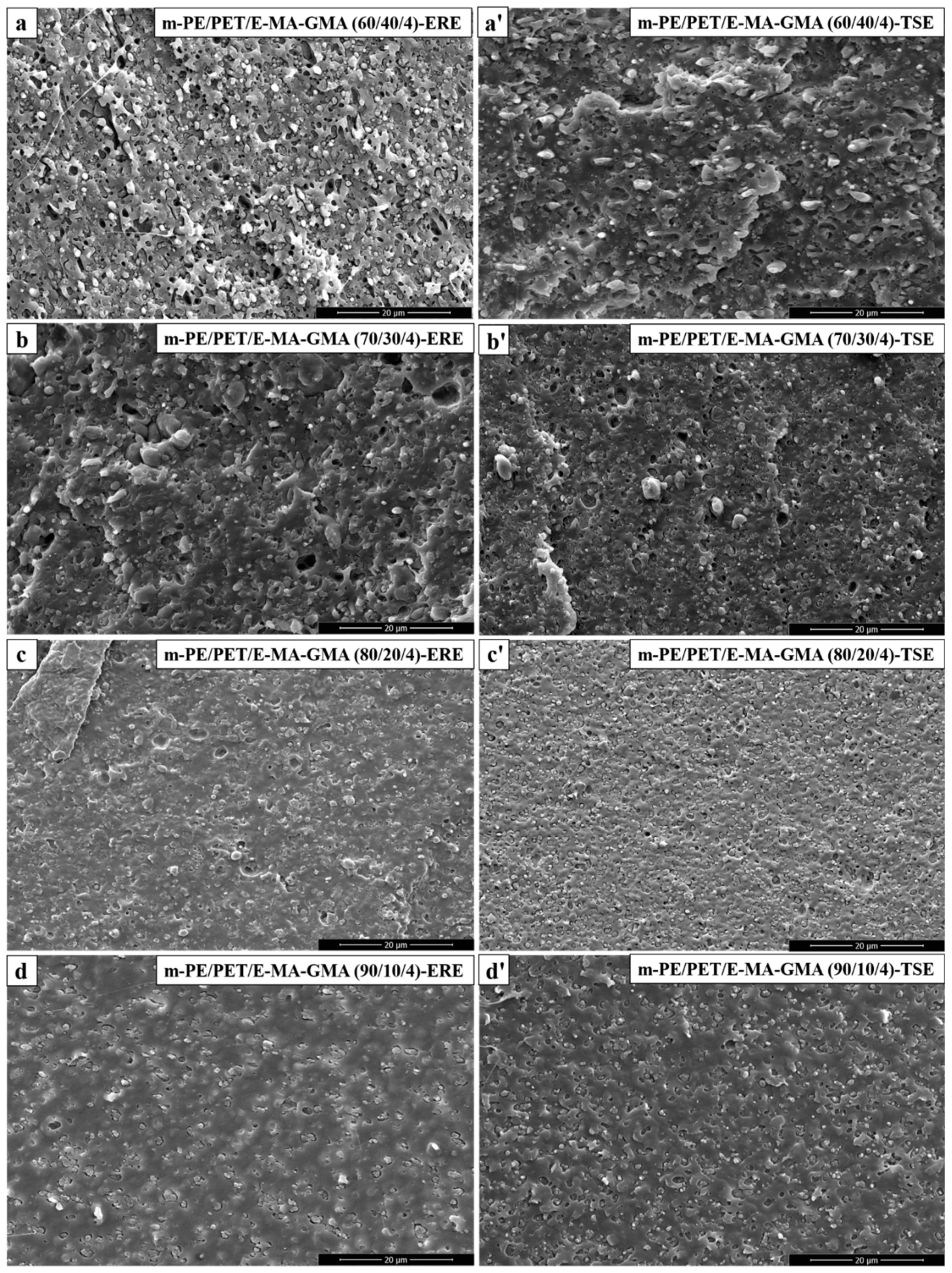
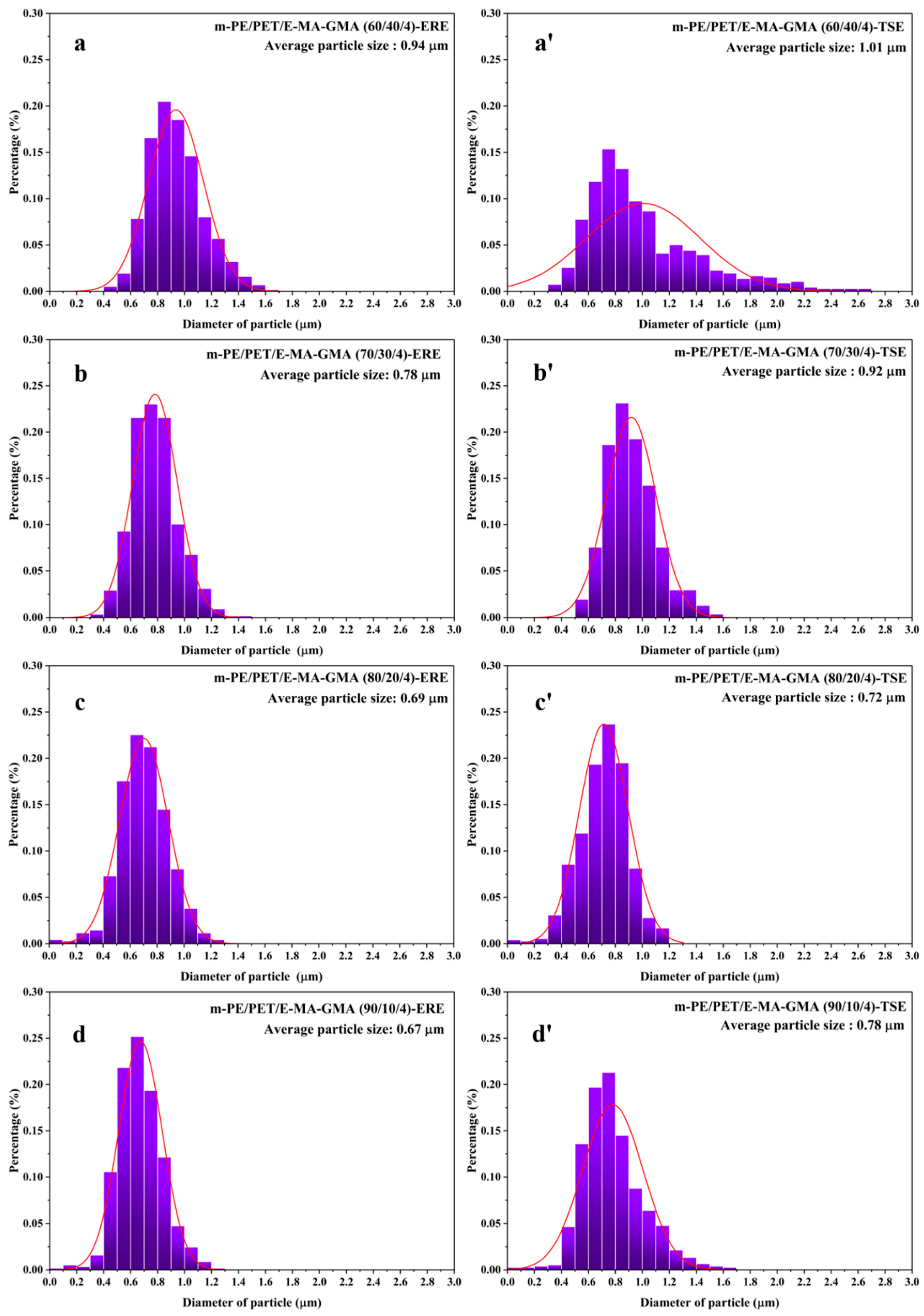
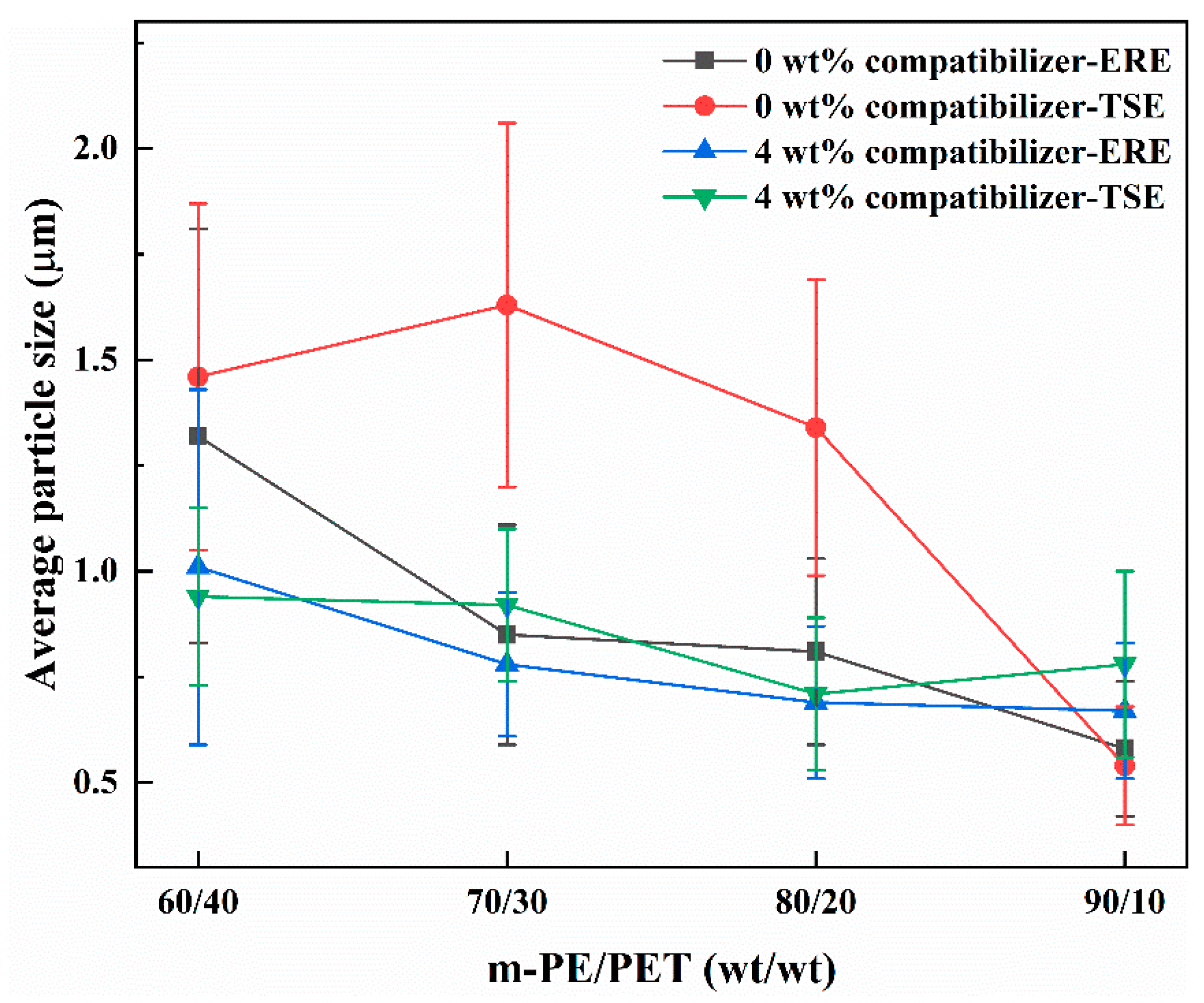

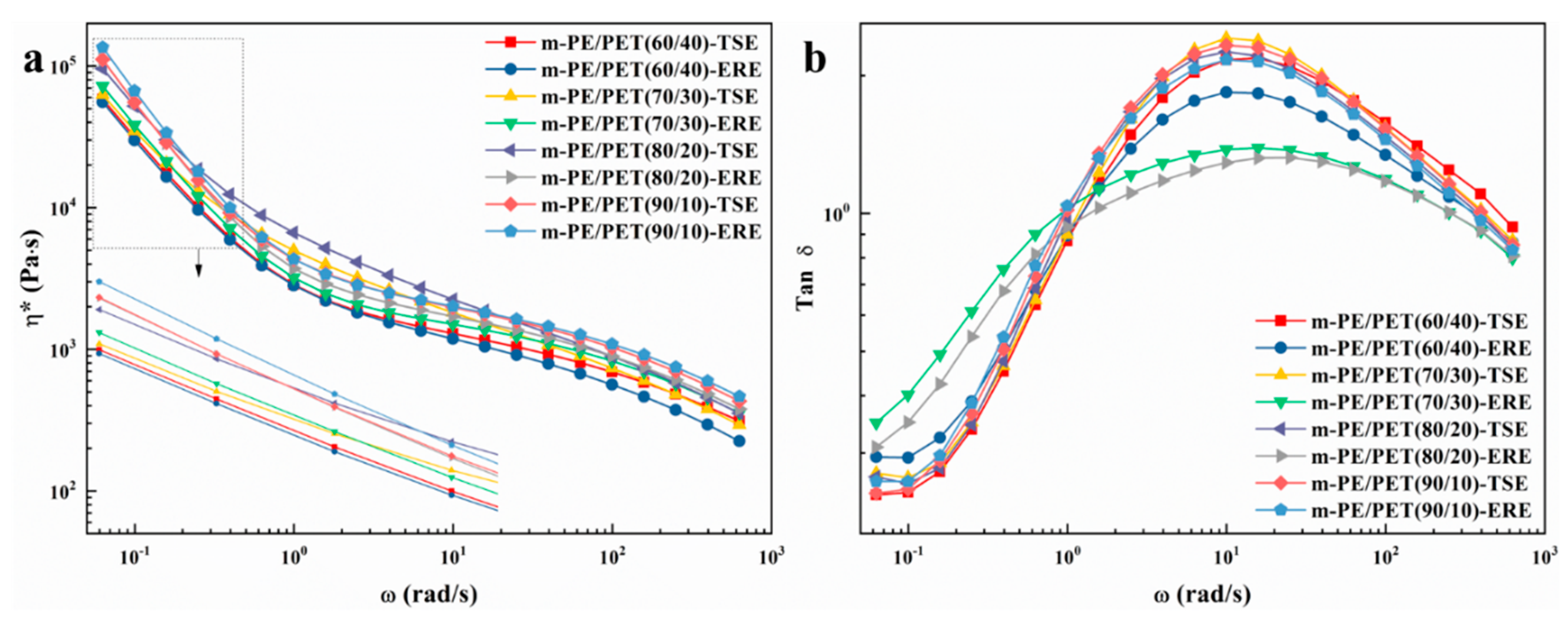


| Sample | Composition | Compatibilizer a (wt%) | Processing Method | |
|---|---|---|---|---|
| m-PE (wt%) | PET (wt%) | |||
| m-PE/PET(60/40)-ERE | 60 | 40 | - | ERE b |
| m-PE/PET(70/30)-ERE | 70 | 30 | - | ERE |
| m-PE/PET(80/20)-ERE | 80 | 20 | - | ERE |
| m-PE/PET(90/10)-ERE | 90 | 10 | - | ERE |
| m-PE/PET(60/40)-TSE | 60 | 40 | - | TSE c |
| m-PE/PET(70/30)-TSE | 70 | 30 | - | TSE |
| m-PE/PET(80/20)-TSE | 80 | 20 | - | TSE |
| m-PE/PET(90/10)-TSE | 90 | 10 | - | TSE |
| m-PE/PET/E-MA-GMA(60/40/4)-ERE | 60 | 40 | 4.0 | ERE |
| m-PE/PET/E-MA-GMA(70/30/4)-ERE | 70 | 30 | 4.0 | ERE |
| m-PE/PET/E-MA-GMA(80/20/4)-ERE | 80 | 20 | 4.0 | ERE |
| m-PE/PET/E-MA-GMA(90/10/4)-ERE | 90 | 10 | 4.0 | ERE |
| m-PE/PET/E-MA-GMA(60/40/4)-TSE | 60 | 40 | 4.0 | TSE |
| m-PE/PET/E-MA-GMA(70/30/4)-TSE | 70 | 30 | 4.0 | TSE |
| m-PE/PET/E-MA-GMA(80/20/4)-TSE | 80 | 20 | 4.0 | TSE |
| m-PE/PET/E-MA-GMA(90/10/4)-TSE | 90 | 10 | 4.0 | TSE |
© 2020 by the authors. Licensee MDPI, Basel, Switzerland. This article is an open access article distributed under the terms and conditions of the Creative Commons Attribution (CC BY) license (http://creativecommons.org/licenses/by/4.0/).
Share and Cite
He, H.-Z.; Xue, F.; Xue, B.; Liu, S.-M.; Huang, Z.-X.; Zhang, H. Improved Properties of Metallocene Polyethylene/Poly(ethylene terephthalate) Blends Processed by an Innovative Eccentric Rotor Extruder. Polymers 2020, 12, 585. https://doi.org/10.3390/polym12030585
He H-Z, Xue F, Xue B, Liu S-M, Huang Z-X, Zhang H. Improved Properties of Metallocene Polyethylene/Poly(ethylene terephthalate) Blends Processed by an Innovative Eccentric Rotor Extruder. Polymers. 2020; 12(3):585. https://doi.org/10.3390/polym12030585
Chicago/Turabian StyleHe, He-Zhi, Feng Xue, Bin Xue, Shi-Ming Liu, Zhao-Xia Huang, and He Zhang. 2020. "Improved Properties of Metallocene Polyethylene/Poly(ethylene terephthalate) Blends Processed by an Innovative Eccentric Rotor Extruder" Polymers 12, no. 3: 585. https://doi.org/10.3390/polym12030585
APA StyleHe, H.-Z., Xue, F., Xue, B., Liu, S.-M., Huang, Z.-X., & Zhang, H. (2020). Improved Properties of Metallocene Polyethylene/Poly(ethylene terephthalate) Blends Processed by an Innovative Eccentric Rotor Extruder. Polymers, 12(3), 585. https://doi.org/10.3390/polym12030585




